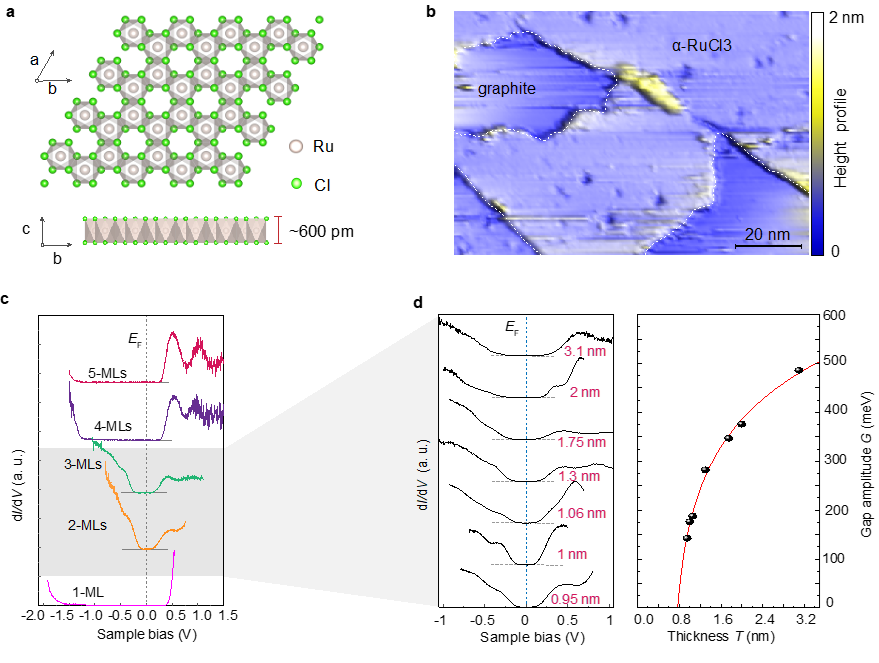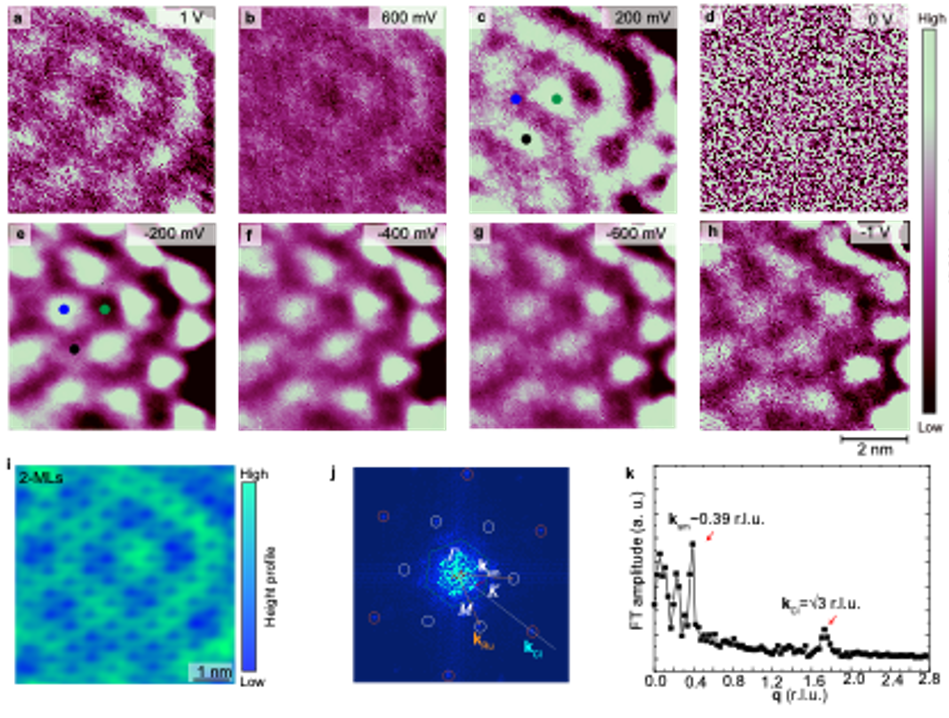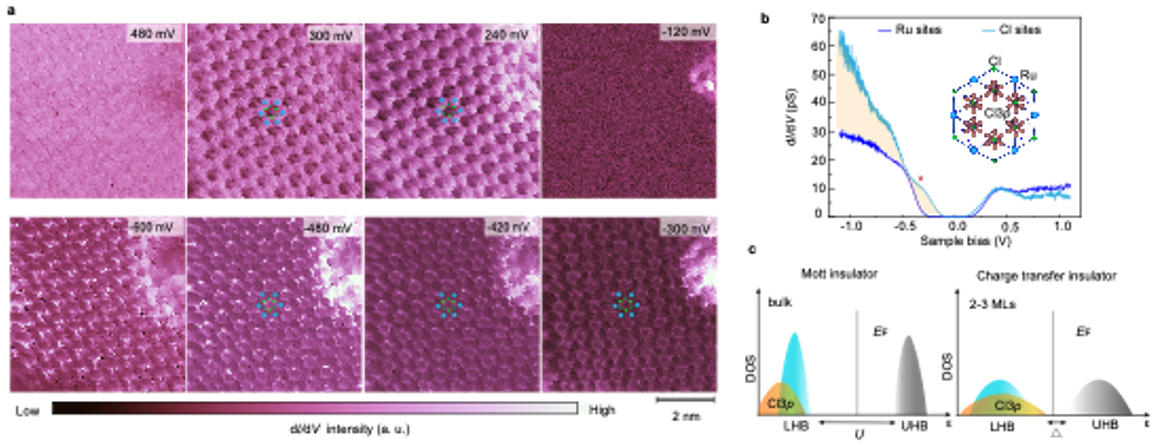Discovery of a novel incommensurate charge order in Kitaev quantum spin liquid candidate α-RuCl3
2024/09/04
The material α-RuCl3, which is considered as a potential candidate for Kitaev quantum spin liquid (KQSL), has garnered significant attention and research efforts. Recently, researchers from the Beijing Academy of Quantum Information Science (BAQIS) collaborated with scientists from Peking University, Renmin University of China, and other institutions to conduct a comprehensive study on the electronic states of α-RuCl3 in close proximity to graphite using scanning tunneling microscopy and spectroscopy (STM/STS). They observed a phase transition from Mott-Hubbard insulator (MI) to charge transfer insulator (CTI) in the layered α-RuCl3 thin film. Furthermore, they discovered a novel form of incommensurate charge order within the CTI phase of α-RuCl3. Theoretical analysis suggests that the interaction between ferroelectric polarization induced in the CTI phase and an interface electric field at the heterostructure is directly responsible for the formation of this unconventional charge order. On 03/09/2024, these research findings were published under the title "Incommensurate Charge Super-modulation and Hidden Dipole Order in Layered Kitaev Material α-RuCl3" in Nature Communications.
In early of the 21st century, physicist Alexei Kitaev discovered that using non-Abelian anyon can completely solve the fault-tolerant problem in quantum computation. He proposed a honeycomb lattice model which has QSL ground state. In this KQSL model, the emergent Majorana fermions can decouple into Ising non-Abelian anyons at defects (Majorana bound states). The candidate material α-RuCl3 has been identified as an ideal platform for investigating KQSL. Previous experiments based on α-RuCl3 have provided evidences for the fractionalized quantum excitations (Majorana fermions and Majorana bound states). However, there are still controversies surrounding these key experimental results. The detection or manipulation of these quantum excitations through electrical methods is widely proposed and anticipated, as it holds great potential for elucidating the non-Abelian quasiparticles and advancing quantum technologies. Therefore, attentions toward comprehending and modulating the Mottness properties of α-RuCl3 have gradually increased within experimental physics.
The BAQIS team, led by Professor Katsumi Tanigaki, has conducted extensive research on the Mott properties of α-RuCl3 and its electronic properties using STM/STS techniques. Their findings include a clarification that the Mott gap of α-RuCl3 is approximately 2 eV, which is significantly larger than previously speculated values of 1.2 eV. They also observed a significant modulation in the electronic density of states for thin films of α-RuCl3 when placed in proximity to graphite or graphene substrates (Physical Review B, 2023, 107:195107). Furthermore, they discovered that lattice strain can induce an insulator-to-metal transition in mono-layered α-RuCl3 on graphite surfaces through charge transfer within heterointerfaces (Physical Review B, 2024, 109:035106).
The main findings of this study reveal that the polarizing electric field at the α-RuCl3/graphene hetero-interface effectively modulates the Cl3p orbitals in the adjacent α-RuCl3 layer, causing them to enter the Mott gap and inducing a transition from a Mott insulator (MI) to a charge-transfer insulator (CTI). This provides a clearer understanding of the previously observed unconventional Mott phase transition. Additionally, it is discovered that upon entering the CTI phase, electrons redistribute among different orbits of freedom in α-RuCl3, resulting in ferroelectric polarization. The interaction between the interface polarization field and the ferroelectric dipole moment in the thin film leads to the observation of a novel incommensurate charge order in α-RuCl3. The emergence of this charge order reflects strong inter-correlations between charge-spin and orbital degrees of freedom in α-RuCl3, which not only provides theoretical basis and potential pathways for probing exotic spin quantum excitations using electron channels but also holds promise for topological superconductivity phenomena in Kitaev materials.

Fig. 1. Unconventional Mott transition in α-RuCl3 in proximity to graphite.
a Crystal structure of α-RuCl3 in the ab and bc planes; b STM morphology of α-RuCl3 flakes transferred on a graphite substrate; c Selected dI/dV spectra taken on α-RuCl3 flakes with thicknesses ranging from 1-ML to 5-MLs; d Left: averaged dI/dV spectra taken on a series of α-RuCl3 thin flakes with different thicknesses. Right: Plots of the relationship between the gap-amplitude (G) and the appropriate thickness (T).

Fig. 2. Incommensurate charge order in α-RuCl3.
a to h show sample bias-resolved dI/dV maps; i Atomic-resolved STM image recorded on the same place in (a-h) shows that the super-modulation is also observable on the lattice; j FFT of the STM image shows peaks of the static super-modulation inside the 1st BZ (green dashed hexagon); k The line cut along the Γ-K direction shows that ksm is approximately 0.39 r.l.u..

Fig. 3. Mott insulator (MI) to charge-transfer insulator (CTI) transition.
a Bias-resolved dI/dV maps taken on 3-MLs α-RuCl3 display the Cl3p orbitals near the Fermi level; b A comparison of averaged dI/dV spectra taken on the Ru and Cl sites reveals enhanced occupied states and distinct dip-humps at Cl sites; c Schematic DOS from MI to CTI.

Fig. 4. Anti-ferroelectricity and the incommensurate dipole order.
a Phase diagram of the dipole model, where ‘AFE’ stands for the anti-ferroelectric phase. Cartoon picture of the dipole distribution in three phases: b The anti-ferroelectric phase (the blue/red arrows stand for A/B- sublattice respectively); c The polarized trivial phase; d The incommensurate dipole order phase. e Illustration of the CDW order associated with the incommensurate dipole order.
The first-author of the paper is Dr. Xiaohu Zheng (BAQIS), the corresponding-authors are Dr. Xiaohu Zheng (BAQIS), Prof. Zhengxin Liu (RUC) and Prof. Rui-Rui Du (PKU). Other co-authors include Mr. Cuiwei Zhang and Prof. Youguo Shi from IOP, Dr Huaxue Zhou, Dr. Chongli Yang and Prof. Katsumi Tanigaki from BAQIS. This work was supported by the National Key R&D Program, the Innovation Program of Quantum Science and Technology, and the National Natural Science Foundation of China, along with support from Beijing Huairou Comprehensive Extreme Condition Experimental Device Micro-Nano Processing Laboratory.
 中文
中文 Email
Email QCloud
QCloud Log in
Log in
